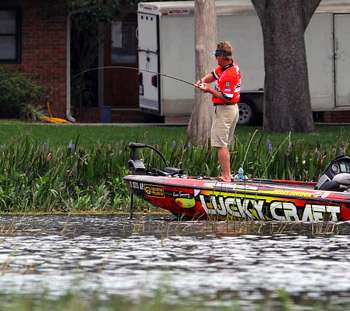
If you're under the impression that fish quit biting when the mercury is about to bust, Elite Series pro Kelly Jordon thinks that you're missing the best fishing of the year. The Texas pro has proved that fishing in the dead of summer can be extremely rewarding. You just have to get a little sweaty.
Jordon credits his warm weather prowess to having fished many lakes conducive to summer presentations in his native Texas, most notably Lake Fork. Jordon feels that there are three places anglers who plan on toughing out the heat should focus on:
(1) thick vegetation
(2) deep structure
(3) docks
Jordon freely admits an affinity for fishing matted vegetation, claiming it gives fish the best place to hide when the sun is high. He suggests looking for vegetation where there are signs of activity, like shad flickering or other indicators that bass may be below.
"My number one favorite summer fishing place is thick, matted vegetation. It is the densest cover, and offers plenty of places for bass to get out of the intense light," he says. "After growing all spring, the plant life is pretty thick, and it starts to top out in summer. The shade this thick stuff offers attracts baitfish and, in turn, bass."
When going after bass tucked up under seemingly impenetrable green stuff, Jordon reaches for his 7-foot, 9-inch Fenwick Techna AV Flippin' Stik and 65- to 80-pound Spiderwire braid — depending on just how nasty the cover is — and he tops it off with a Lake Fork Tackle Fork Craw in junebug or Blue Bruiser and a 1- to 1 3/4-ounce tungsten weight. While this is about as stout a bass setup as you'll find, it's completely necessary to penetrate the grass and get to where the bass are holding.
"If you can get that craw or worm in there, it'll be right in their living room," he says.
But if the lake you're fishing doesn't have grass or any significant vegetation, deep structure is another favorite bass haunt in midday. It can be intimidating for some anglers who are not sure where deep bass can be found or who aren't familiar with the techniques that can catch these deep fish.
"Deep offshore structure can be one of the most productive spots for fishing where there is no other obvious cover," Jordon says. "Even if you don't have a depthfinder, you can be successful finding these fish. It just takes a little more time."
Jordon's go-to technique for deep fishing in the warmer months is crankbaiting. He suggests deep divers like the Lucky Craft D20 for deep or suspended bass. He prefers natural colors that imitate the natural forage of the lake you're on for clear waters, like those often found in Texas, and brighter shades such as the Chartreuse Shad for stained or murky waters. Crankbaits are also useful for those without a sonar unit, as they allow you to cover lots of water quickly. Jordon uses a 7-foot medium action Fenwick Techna AV with 10- to 12-pound Trilene 100% fluorocarbon for his cranking.
For a faster approach to deep water bassin', Jordon goes to his arsenal of swimbaits which are also good for finding fish. When using swimbaits, Jordon goes with a 7-foot, 9-inch Fenwick Techna AV Flippin' Stik with 25-pound Trilene 100% fluorocarbon line.
If he needs another option, Jordon goes to spoons, most notably a 5-inch weedless Lake Fork Tackle Big Joe Spoon, a lure which he says will help win several of the upcoming tournaments. He uses the same big flippin' rod, but with 17- to 20-pound fluorocarbon.
"I like to either make long casts with it and burn and kill it or jig it vertically if I'm on a school," he explains.
When it's hot enough to make the devil sweat, naturally you go for the shade. Bass do the same. Perhaps the most obvious place to find shade — other than mats of grass — is under and around docks. When looking for the right dock to fish, Jordon looks for baitfish, as the bass have probably followed them.
"When I'm on a dock, there are two colors of lures I use, the first being a bream color — so go with green pumpkin patterns," he says. "Another good choice is anything shad-based, like white colors."
Once he's found a dock he likes, Jordon uses tubes and jigs as primary baits. Any will do as long as they match the baitfish of the area. He pitches them under and around the dock, or makes long casts to reach them if they're holding on the perimeter of the dock. For this he likes his 7-9 Flippin' Stik and Trilene fluorocarbon.
Jordon offers a final piece of advice for late summer bass action: "Lots of lakes either develop a thermocline or it becomes more distinct in late summer. A good rule of thumb is that fish will hold about 10 feet above it, as the water within it doesn't have enough oxygen to support the fish or the bait they're after. You can expect to find it anywhere from 10 feet all the way down to 40."
Summer fishing can pay off — even in the heat of the day — if you know what to look for. Before you decide to call it a day when the sweat starts forming on your brow, reconsider and give Jordon's hotspots a try.
Originally published August 2011




